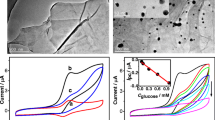Abstract
Glucose biosensors have been formed with glucose oxidase (GOD) immobilized in composite immobilization membrane matrix, which is composed of hydrophobic gold, or hydrophilic gold, or hydrophobic silica nanoparticles, or the combination of gold and silica nanoparticles, and polyvinyl butyral (PVB) by a sol-gel method. The experiments show that nanoparticles can significantly enhance the catalytic activity of the immobilization enzyme. The current response can be increased from tens of nanoamperometer (nA) to thousands of nanoamperometer to the same glucose concentration, and the electrodes respond very quickly, to about 1 min. The function of nanoparticles effect on immobilization enzyme has been discussed.
Similar content being viewed by others
References
Zhao, J., Henkens, R. W., Stonehuerner, J. et al., Direct electron transfer at horseradish peroxidase-colloidal gold modified electrodes, J.Electroanal. Chem., 1992, 327: 109.
Li, Q., Zheng, G.B., Xi, S.Q., Nanoparticles, Huaxue Tongbao (in Chinese), 1995, 6: 29.
Moremans, M., Daneels, G., Demey, J., Sensitive colloidal metal (gold or silver) staining of protein blots on nitrocellulose membranes, Anal. Biochem., 1985, 145: 315.
Stober, W., Fink, A., Controlled growth of monodisperse silica in the microsize rang, Journal of Colloid and Interface Science, 1968, 26: 62.
Tang, F.Q., Li, J.R., Yuan, J.S. et al., Two electrode glucose oxidase biosensors using LB film, Chemical Sensor(in Chinese), 1999, 10(1): 26.
Tang, F. Q., Zhang, L., Jiang, L., Improvement of enzymatic activity and lifetime of Langmuir-Blodgett films by using submicron SiO2 particles, Biosensors & Bioelectronics, 1992, 7: 503.
Zhang, L., Tang, F. Q., Jiang, L. et al., Preparation of glucose oxidase electrode containing hydrophobic silica nanoparticles by the sol-gel method, Science in China, Series B, 1995, 38(12): 1434.
Crumbliss, A. L., Perine, S.C., Stonehuerner, J. et al., Colloidal gold as a biocompatible immobilization matrix suitable for the fabrication of enzyme electrodes by electrodeposition, Biotechnology and Bioengineering, 1992, 40: 483.
Khmelnitsky, Y. L., Levashov, A. V., Klyachko, N. L. et al., Engineering biocatalytic systems in organic media with low water content, Enzyme Microb.Technol., 1988, 10: 710.
Chen, Z. J., Ou, X. M., Tang, F. Q. et al., Effect of nanometer particles on the adsorbability and enzymatic activity of glucose oxidase, Colloids and Surfaces B: Biointerfaces B:Biointerfaces, 1996, 7: 173.
Author information
Authors and Affiliations
Corresponding author
Rights and permissions
About this article
Cite this article
Tang, F., Meng, X., Chen, D. et al. Glucose biosensor enhanced by nanoparticles. Sc. China Ser. B-Chem. 43, 268–274 (2000). https://doi.org/10.1007/BF02969521
Received:
Issue Date:
DOI: https://doi.org/10.1007/BF02969521




